|
|
| Разместил (Author): |
SergUA6  |
| Авторские права |
© http://www.radioscanner.ru |
|
|
Текст
|
OFDM analysis in SA version 6.2.3.3
SA version 6.2.3.3 in contrast to the previous versions has the following advantages:
- speed of search of the correlation triangle has been increased
- the brose viewing mode of the loaded signal has been added into OFDM module
- "Get Br" function has been optimized.
Let's consider, whenever possible in detail, an example of the analysis of signal CIS-112 . The record.
This signal have been chosen for the several reasons:
- In the first, the quality of the record is rather high.
- In the second, this signal had caused rough enough discussion concerning the parameters.
- In the third, the signal is short enough, and it is desirable to apply some working methods with OFDM module, although all these methods were considered already, nevertheless, it will be usefull to remind them.
- And the most important thing is that the work in OFDM module is usually connected with some difficulties to many SA users, ( not to all of course ), and thereupon, in my opinion, any example of the work in OFDM module will be very usefull and interesting.
I'm reminding, that the signal review mode has been added according to users offers.
The signal looks like this on the spectrum:
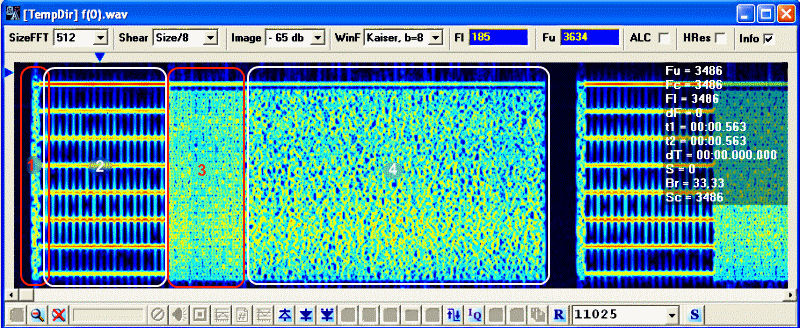
Four various fragments are well visible.
In the previous SA versions, it was necessary to load only the signal's body into OFDM module for the correlation trianlge search, because correct calculations CT are impossible on preambles and starting segments (such as pilot-tones).
In the current version, it is possible to load whole signal (if it is required), the only one condition is do not grasp empty space after the signal, if it is possible.
As it is possible to select the start point, and not possible to select the breakpoint, it means the whole signal will be analyzed and displayed on the phase planes till the end, and noise presence can strongly grease the picture, or break the working process of "Get Br" function.
Let's begin.
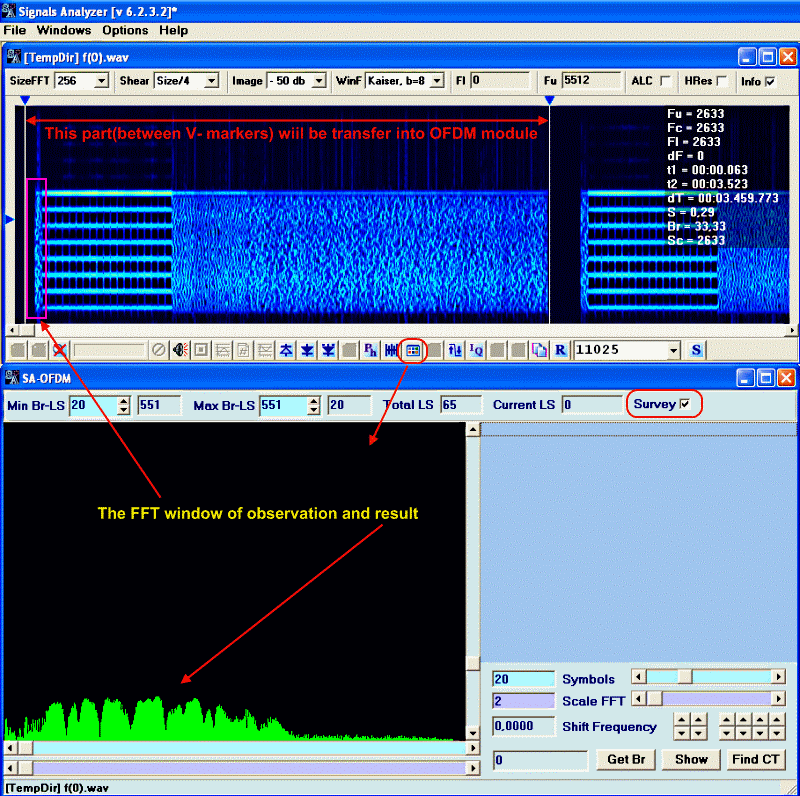
The review mode is switched on by default.
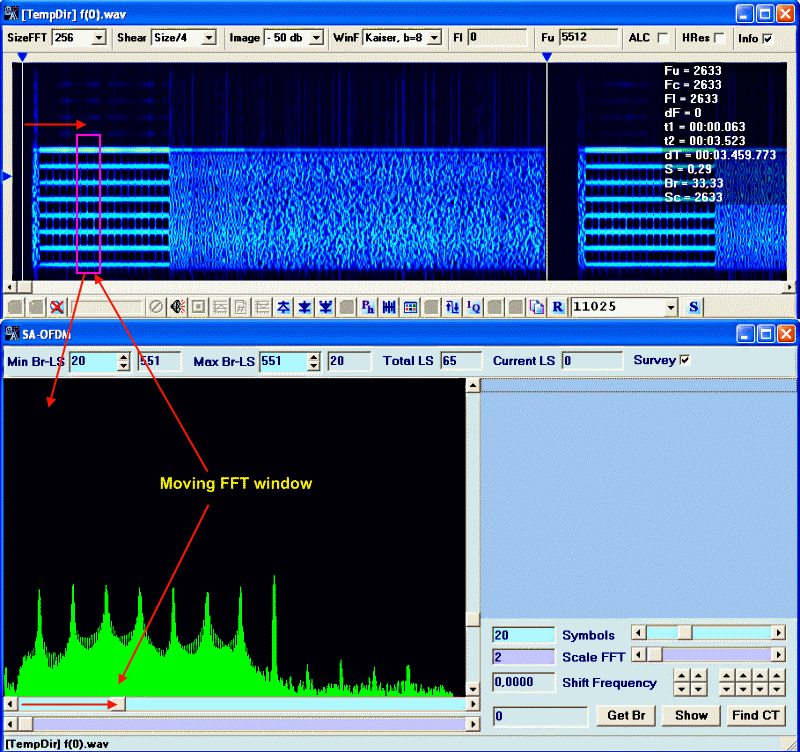
We are moving the monitoring window by moving the slider, which is specified on the picture. Thus, we can place the start point into necessary position, controlling an accuracy of hit on the spectrum.
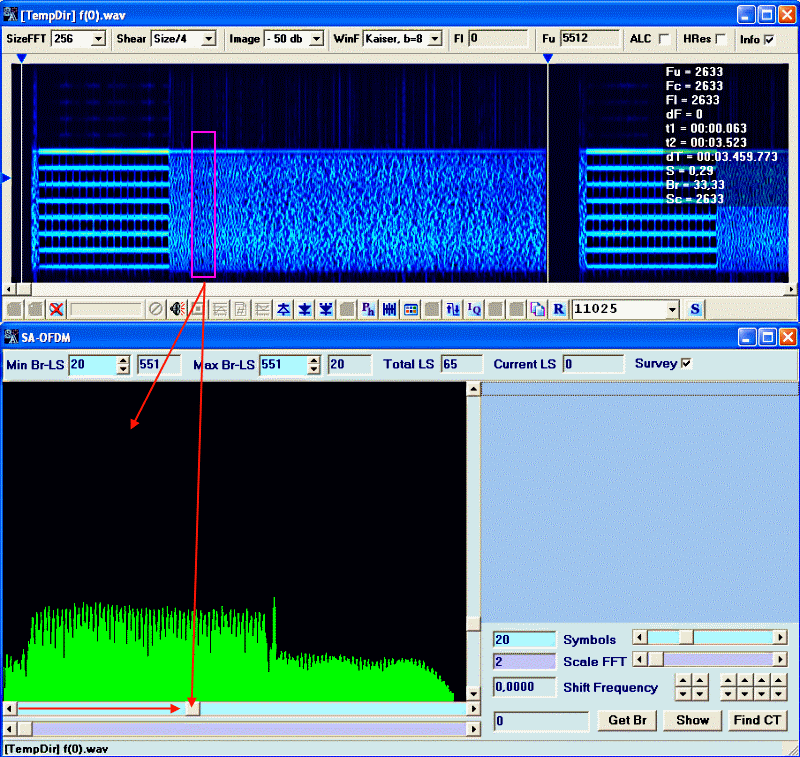
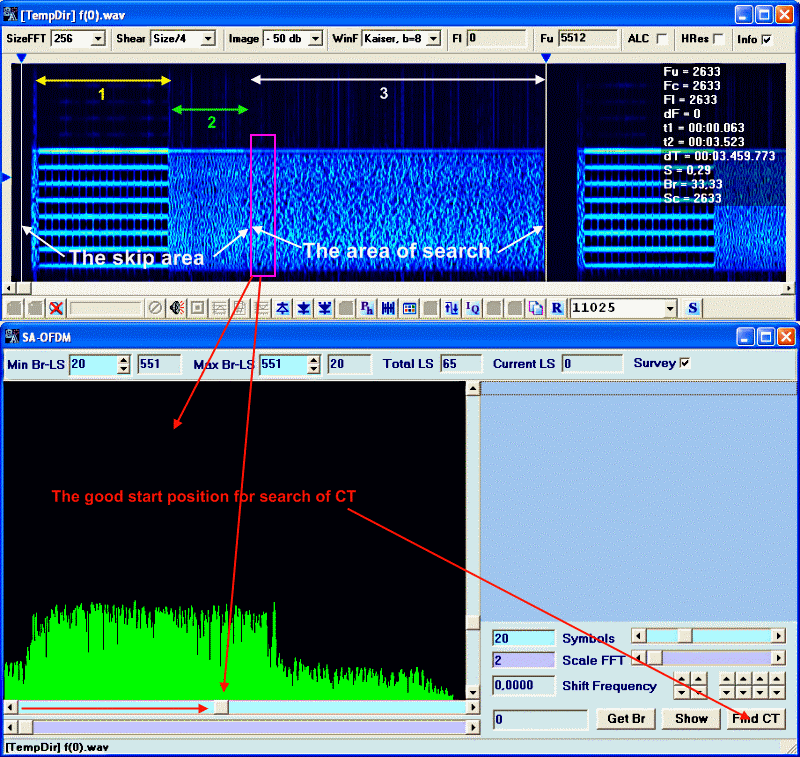
The monitoring window has the constant size (1024 counts), nevertheless, it allows to fix precisely enough the begining of the necessary fragment.
As soon as the start position is defined, it is possible to start the program aiming on searches of the correlation triangle(CT).
The algorithm of CT search has been strongly optimized by the time parameter. In the current version finding of the correlation triangle is realized much faster than in old SA versions, even at not optimum initial conditions(by default).
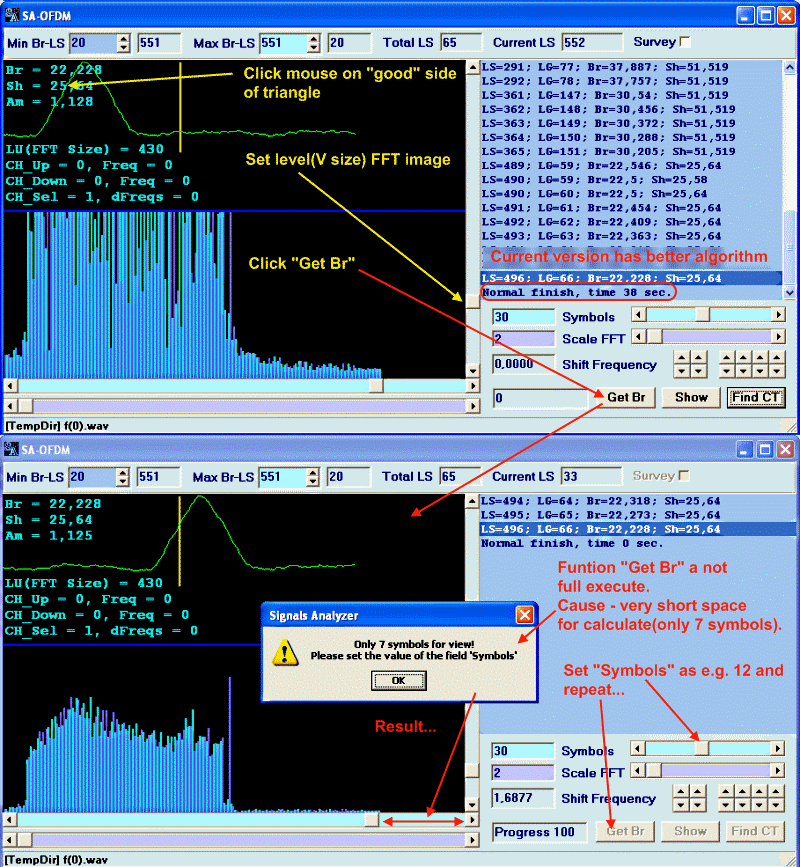
After CT was being found, it does not mather if it is positive or negative triangle, You need to place the triangle into optimum position concerning the marker by mouse click on the left(good) side of the triangle. After you need to call "Get Br" function.
- the result of work of this function will be:
- the signal's positioning by frequency
- recieving of precise value of the clock frequancy of manipulation.
In our example, the function is not completely fulfiled. It is connected with the fact, that the basic body of the signal is short, and thus, the program can't collect the necessary statistics at the quantity of symbols in the block (30), which is used for calculations of the clock frequency. There are not enough blocks. The quantity of blocks can be increased, having reduced the size of the block. It is not recommended to make the size of the block less than 6-8 symbols, 20-30 is the optimum size. But in case of necessity, like in this example, it is possible to reduce this parameter. And to repeat call of "Get Br" function.
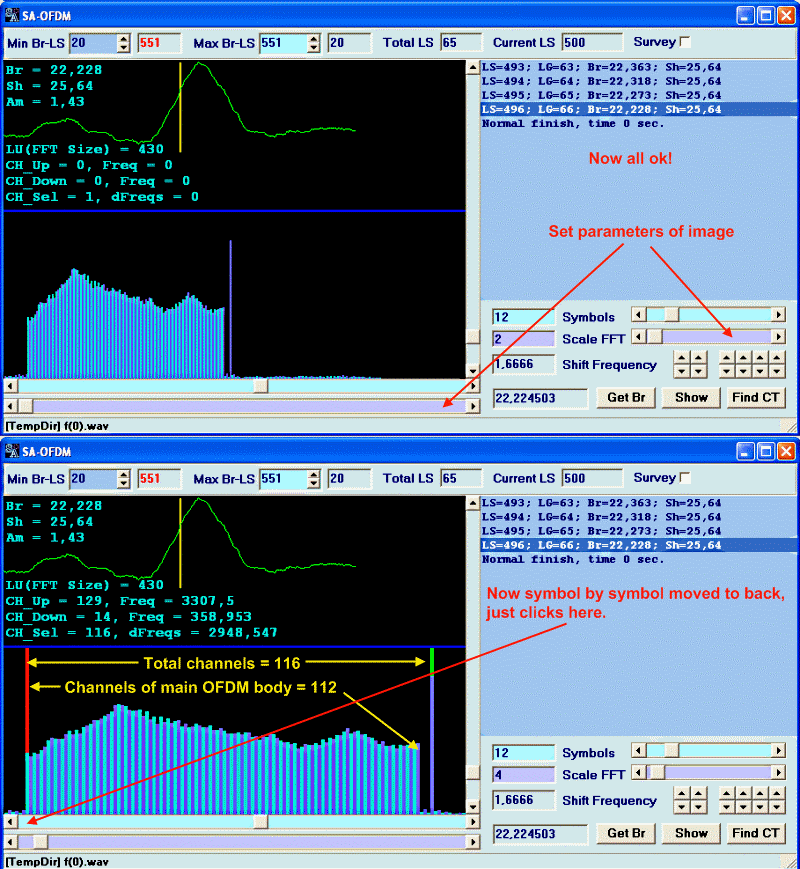
After successful performance of "Get Br" function:
1 - The signal will be shifted in the optimum position by frequency,
2 - value of the clock frequency will be received.
It will be probably necessary to correct position of the correlation triangle concerning the marker, because the marker can be displaced, it isn't excluded.
Now, when we have necessary parameters of the signal, it is possible to move on the fragment beginning in the module, and to research the whole signal in details.
It is necessary to move back at the beginning symbol-by-symbol! Because on preambles or starting tones, the correlation triangle can disappear, and it will be impossible to define the symbol's beginning, or spreading behind borders (limits) of the symbol. In this signal it is no so, and CT is well visible in the beginning aswel, but we simply had luck.
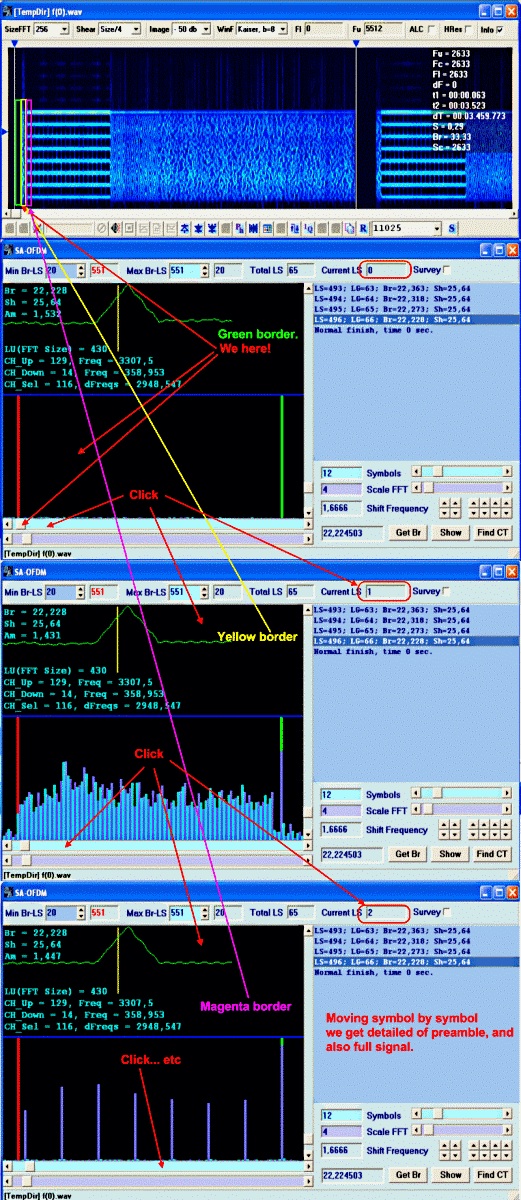
There is step-by-step movement by the fragment in module OFDM is shown on the picture, this movement has begin from the start point, which is located exactly up to one symbol before OFDM signal itself will appear.
It is well visible that the "noise" fragment in the beginning is nothing else but the single symbol after which, the Preamble follows, and after the preamble follows the special part of even channels, and after that follows full OFDM signal itself.

Concerning the even channels: it is conditional parity of course. It is enough to shift the signal precisely on one channel upwards or downwards by the frequency, and the special part will consist of odd channels. I hope it is clear. In this case, it is important that in this part the channels are used next nearest.
The further steps, which consist of recieving of the constellations in the channels, getting the preamble and the special part, should not cause special difficulties. So I will not "stop" on them in details.
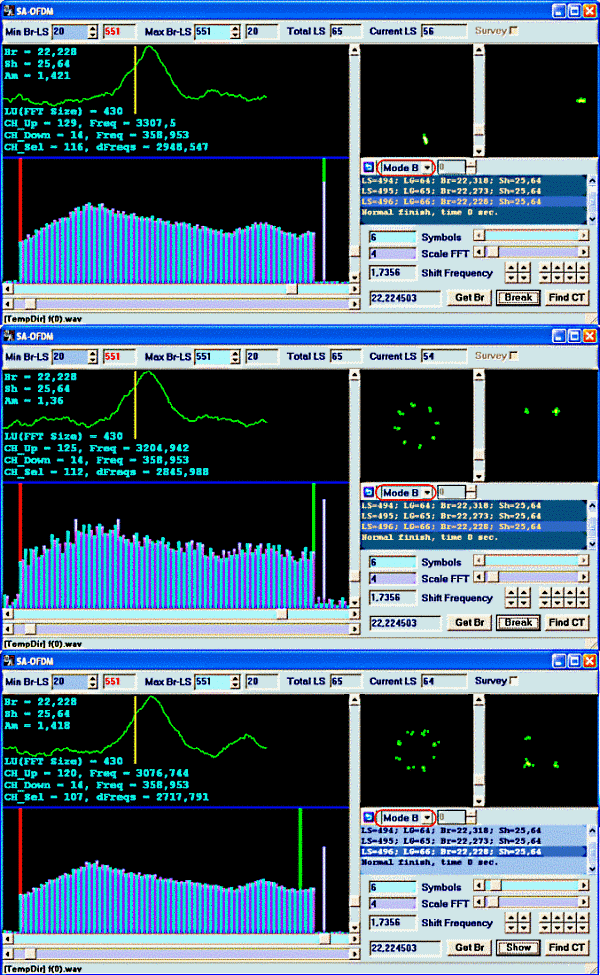
An exact position of the signal by the frequancy is defined and corrected by the pilot-tone. The manipulation mode as pi/4 dqpsk is easily defined in the channels nearest to the pilot-tone. In proportion as the distance between the channel and the pilot-tone is increasing, the correction of the signal position by the frequancy is required.
Key parameters of OFDM core (kernel) such as LS and LG are still unknown. As you remember, defining of these parameteres is the one of the primary goals. And determination of these parameters is the extremely important task of OFDM analysis. Although we are close to the decision, we are still at the stage of working off. We are still in the process of ideas and algorithms estimation, control and exmanination. We have very perspective variants. However, time will show. :-)
Of course, this example doesn't cover all the problems of the analysis of real OFDM signals. Nevertheless it is sufficent as the basic approach to OFDM analysis using SA last versions.
Good Luck~
|
|
|
|
Добавлять комментарии могут только зарегистрированные, активировавшие регистрацию и не ограниченные в доступе участники сайта!
|
| Файл создан: 29 Dec 2010 11:54, посл. исправление: 29 Dec 2010 14:16 |
|

